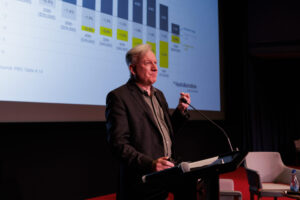by Ebony Bennett
[Originally published in The Canberra Times, 06 April 2019]
Look out, it’s a trap! The centrepiece of the Coalition’s budget is more than $300 billion worth of income tax cuts. This sounds great in theory. In reality, the Coalition has committed to a radical plan to flatten Australia’s progressive tax system. If implemented, this would represent a nightmare scenario for addressing inequality: The tax cuts package will bake both inequality and budget deficits into our tax system for future generations.
Prime Minister Scott Morrison and Treasurer Josh Frydenberg arrive for early morning interviews at Parliament House on Wednesday after delivering a budget that promised tax cuts in the years to come.
The Coalition has pulled this trick before. The permanent income tax cuts Peter Costello introduced during the temporary mining boom reduced the budget’s ability to generate revenue for more than a decade. The tax cuts mostly benefitted the wealthiest Australians, while the subsequent budget deficits have been used by the current government as a reason to cut spending, which mostly hurts low income earners and women. Neat trick, huh?
Australia is heading to a federal election with some genuine choices to make.
The Coalition, in its budget, is doubling down on climate change inaction, on its promise that wages will magically rise, and on trickle-down economics with its top end tax cuts (and let’s not forget the Nationals’ strategy for fixing the failed Murray Darling Basin Plan, which is apparently to cross their fingers and hope for rain).
Before the election campaign begins, it’s important we understand the Coalition’s plan to flatten Australia’s progressive income tax system.
The government’s tax plan has two parts. Together, they represent more than $300 billion in lost revenue over 10 years and they radically reshape the purpose of income tax. In short, by 2024-25 when the tax cuts are fully implemented, the tax cuts will make Australia’s income tax system less progressive, hand billions to high income earners and for every $1 in tax cuts that goes to women, $2 goes to men.
Part one is tax cuts for low and middle-income earners that begin at the end of this financial year and expire in 2021-22. For the sake of brevity, let’s focus on part two, where the real problems and key differences emerge.
Part two of the Coalition’s tax cuts package drastically flattens the income tax scales and will be fully implemented by 2024-25, it removes the 37 cent tax bracket entirely and decreases the 32.5 cent tax bracket to 30 cents. But just because part two doesn’t kick in for an election or two, doesn’t mean we can afford to ignore it.
Australia Institute research shows more than half of the benefit of flattening the tax scales will go to the top 20 per cent of taxpayers. At the other end of the income scale, the bottom 20 per cent of taxpayers get only 3 per cent of the benefit.
Treasurer Josh Frydenberg claims these tax cuts are progressive. “Well the fact is, someone on $200,000 under our plan pays 10 times as much tax as someone who’s on $45,000,” he told the ABC.
Frankly, this is blatant econobabble and we shouldn’t fall for it.
When you earn five times more than someone else, of course you’re going to pay more tax than them. Income tax in Australia is a progressive tax, where those on higher incomes pay a larger proportion of their income in tax. Australia is the land of the fair go and our tax system is designed to reflect that. When someone earning $200,000 pays the same marginal income tax rate as someone earning $45,000 – that’s not progressive. Period.
Back in 2005, during the Howard years, the top tax bracket kicked in at $70,000 and today it kicks in at $180,000. Back then about 13 per cent of taxpayers were in the top tax bracket, now it’s about 4 per cent of taxpayers in the top tax bracket.
But just because someone earning $200,000 will be in the middle-income tax bracket in 2024, doesn’t make them a middle income earner. The median income is $58,000, meaning half of Australians earn even less. That’s the middle. And the Coalition is trying redefine $200,000 a year as the new middle.
It is like if you were 6 foot 4 – the fact is you are tall. If you met an NBA team, you might feel short by comparison, but your feelings don’t trump the fact that you are objectively tall. The same goes if you are earning $200,000 a year – just because you feel like you’re middle-income, doesn’t change the fact that you are objectively a very high income earner.
If this plan to flatten our progressive tax system comes into effect, it will mean that in the future those on higher incomes will pay less tax as a proportion of their income and the amount of income tax collected will be far less. The consequences will be less revenue for essential government services. These are the same services that are relied on by both the rich and poor.
But it gets worse. The Coalition government’s plan to flatten the income tax scales is skewed against women because more men earn higher incomes and more women earn lower incomes.
By the time the tax cut is fully implemented in 2024-25, for every $1 of benefit women get from the tax cuts, men get $2. In other words, men benefit twice as much from the tax cuts as women. In the top 10 per cent of income earners men get almost three times more benefit than women from the tax cuts.
Last year, then Treasurer Scott Morrison scoffed at the Australia Institute’s distributional analysis, saying, “You don’t get a blue and a pink form to fill out your tax return.”
That’s true, but so is the fact that men will end up with twice as much benefit as women from these income tax cuts. The intention might not be to discriminate against women with tax cuts, but that’s certainly the outcome, whether the government wants to acknowledge it or not.
For years the polls have demonstrated that people are willing to pay more tax if they get quality services in return.
Labor’s $2.3 billion Medicare Cancer Plan, announced in its budget reply, is effectively a social bargain that if you clearly explain to the public exactly what services their taxes and the Medicare levy is paying for, people will be happy enough to reject big tax cuts.
Bill Shorten’s budget pitch sharpened this proposition with laser-like precision into a single question, “If someone you love had cancer, you would sell the shirt off your back. But should you have to?”
Whichever party the electorate sends into government in May, the Senate and crossbench will ultimately have to answer that question, as well as the larger question of whether Australians want to see our progressive tax system preserved or destroyed.
Ebony Bennett is deputy director of the Australia Institute. Twitter: @ebony_bennett
Between the Lines Newsletter
The biggest stories and the best analysis from the team at the Australia Institute, delivered to your inbox every fortnight.
You might also like
Stage 3 Better – Revenue Summit 2023
Presented to the Australia Institute’s Revenue Summit 2023, Greg Jericho’s address, “Stage 3 Better” outlines an exciting opportunity for the government to gain electoral ground and deliver better, fairer tax cuts for more Australians.
Stage 3 Tax Changes: A Win for Australians & Sensible Policy
Politicians are often accused of backflipping when they change their minds.
RN Breakfast: Redesigning the Stage 3 Tax Cuts
Richard Denniss joins ABC RN Breakfast with Patricia Karvelas to discuss redesigning the Stage 3 tax cuts.


